Quark tart with asparagus

- Share via
Take some milk, add a little acid and give the mixture time to do its thing -- who would have thought homemade cheese could be this simple? What with all the equipment and specialized ingredients I’d read about, cheese making sounded as if it were better suited to a chemistry lab than to my tiny kitchen. That is, until I tried quark.
I know. Hear the word “quark” and you may conjure up images of dancing physics particles or “Star Trek” characters. Or of wending your way through “Finnegans Wake.” Any of which might be even scarier than the thought of actually making cheese.
But quark is just the German word for “curds.” A creamy, fresh cheese, quark’s curds come together to form something magical -- rich with a gentle tang, it’s spreadable, kind of a cross between sour cream and soft ricotta. Variations of the cheese can be found throughout Scandinavia and Eastern Europe.
And it’s easy to make: Bring a couple of cups of milk to a simmer over moderate heat, then let it come to room temperature. Whisk in some acid (typically buttermilk, though some recipes call for lemon juice) and leave the mixture at room temperature for a day or so until curds form and the mixture thickens. Strain it to remove the clear whey, and voila! You’ve got cheese.
Methods vary. I tried more than a dozen recipes in searching for the method I liked best. Several were more complicated than what I’ve described -- managing all of the individual components, at times hovering over the stove with a thermometer in one hand and a timer in the other. It finally dawned on me (after I’d set my alarm so I could wake up on time to check on a batch of cheese incubating in the oven) that perhaps things need not be this complicated.
And, in fact, the most basic method made for the best flavor and texture. What’s more, I didn’t even need a thermometer.
I took a couple of batches over to Norbert Wabnig, the Austrian-born owner of the Cheese Store of Beverly Hills, to see what he thought. He took one bite, then eagerly took another. “This is better than what I carry at the store,” he said, wanting to know my secret.
It’s nothing, really -- just a cheese recipe so simple that even a beginner like me can’t mess it up.
Six ways to go with quark
* Use it as you would yogurt, stirring in some granola and fresh fruit for an easy, on-the-go breakfast.
* Spread it over toast or bagels or in between sandwich layers for a little extra tang and richness.
* Dollop it over potatoes or rich pasta dishes, even ragus.
* Lighten it with a little whipped cream and a grating of fresh lemon zest, and use it to fill crepes.
* Use it as a filling for omelets, frittatas or ravioli; quark is used as a filling in certain cheesecakes and strudels.
* Mix it with a little fresh goat cheese, paprika and chopped chives. It makes a perfect dip or spread.
Heat the oven to 400 degrees.
Blanch the asparagus in a large pot of salted boiling water just until the spears turn a bright green, about 1 minute. Strain and remove to an ice bath. Cut the spears on the bias into one-fourth-inch-thick pieces. Set aside.
In a large skillet, saute the bacon over moderately low heat, stirring often, until it has rendered the fat and is crisp, about 15 minutes. Transfer the bacon bits to paper towels to drain. Add the leeks to the drippings and saute until limp and lightly browned, about 5 minutes. Add the sliced asparagus to the skillet, toss lightly to mix, then transfer the mixture to a large mixing bowl.
In the bowl of a food processor, combine the quark, cream, Parmesan, nutmeg, salt and pepper for about 20 seconds until smooth. Pulse in the eggs, one at a time. (Alternatively, the quark, cream, Parmesan, nutmeg, salt, pepper and eggs can be whisked in a bowl until creamy.) Pour the quark mixture into the large bowl, add the Emmentaler and reserved bacon, and toss well to mix.
Set the pie shell on a heavy-duty baking sheet and pour in the quark mixture. Bake, uncovered, for 10 minutes. Reduce the oven temperature to 325 degrees and continue to bake until the tart is lightly browned and set like custard, and a knife inserted toward the center comes out mostly clean, 50 to 60 minutes. Remove the tart from the oven and cool on a rack 45 minutes before slicing. To serve, cut into slim wedges.
Get our Cooking newsletter.
Your roundup of inspiring recipes and kitchen tricks.
You may occasionally receive promotional content from the Los Angeles Times.















